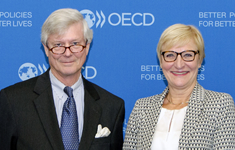 NEA Steering Committee for Nuclear Energy elects next Chair
NEA Steering Committee for Nuclear Energy elects next Chair
Mrs Marie‑Elise Hoedemakers, Senior Policy Advisor for International Nuclear Affairs at the Ministry of Economic Affairs of the Netherlands, has been elected as the next Chair of the NEA Steering Committee for Nuclear Energy, replacing Mr Richard Stratford of the US Department of State. Since 2011, she has been serving as a Vice‑Chair in the Steering Committee Bureau. Mrs Hoedemakers, who will become Chair on 1 January 2015, is the first woman to do so in the history of the Committee. "I am very pleased with the Steering Committee decision and am looking forward to working with Mrs Hoedemakers," said NEA Director‑General Mr William D. Magwood, IV. "Her professional and personal qualities, combined with her extensive knowledge of NEA Steering Committee affairs, will be a great asset as we pursue future developments at the Agency."
Poland joins the NEA Data Bank
The NEA is pleased to announce that Poland has become the 25th country to join the NEA Data Bank, effective as of 24 October 2014. As Poland pursues the development of its nuclear power programme, access to the NEA Data Bank, an internationally recognised centre of reference for nuclear data tools and services, becomes increasingly important. NEA Director‑General Mr William D. Magwood, IV greatly welcomes Poland's membership, and notes that "this is another important step in Poland's efforts to build a robust infrastructure for the safe use of nuclear power in the future."
Exclusion of Nuclear Installations Being Decommissioned from the Application of the Paris Convention
The NEA Steering Committee for Nuclear Energy adopted the Decision and Recommendation Concerning the Application of the Paris Convention to Nuclear Installations in the Process of Being Decommissioned on 30 October 2014. The purpose of this Decision and Recommendation is to provide updated technical exclusion criteria, replacing the 1990 criteria that were in force. It should be noted that the criteria are relatively conservative, and some nuclear installations in the process of decommissioning will not, at first, be eligible for exclusion. However, at some point during the decommissioning process, the nuclear installation would meet the criteria and could be excluded from the Paris Convention nuclear liability regime, relieving the operator from the obligation to have and maintain the specific, high‑level nuclear liability insurance coverage. The Decision and Recommendation's Appendix and Explanatory Note are also available online.
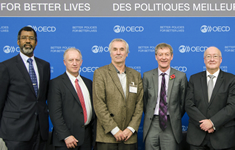 NEA Steering Committee Policy Debate on the Thorium Fuel Cycle
NEA Steering Committee Policy Debate on the Thorium Fuel Cycle
On 31 October 2014, the Steering Committee for Nuclear Energy held a policy debate on the thorium fuel cycle to discuss whether the introduction of a thorium fuel cycle could become a practical option, as well as the technical challenges associated with the various approaches to the use of thorium fuel. Speakers included Mr Kevin Hesketh of the UK National Nuclear Laboratory, Dr Richard Didsbury of Atomic Energy of Canada Limited (AECL), Dr Frank Carré of the French Alternative Energies and Atomic Energy Commission (CEA) and Dr Victor Ignatiev of the Kurchatov Institute, Russian Federation. The NEA is in the final stages of publishing a report which will provide a clear, objective assessment of the thorium fuel cycle and its prospects
NEA takes part in the World Nuclear Exhibition
On 14‑16 October, the NEA participated in the first edition of the World Nuclear Exhibition (WNE) in Le Bourget, France, which brought together key figures in the global nuclear energy industry, drawing over 7 000 visitors from 71 countries. NEA Director-General Mr William D. Magwood, IV was a featured speaker in the panel discussion on Preparing the future of nuclear energy. Mr Kevin Charlton of the Nuclear Development Division participated in the panel discussion on Radionuclides and health. NEA representatives were present throughout the Exhibition at its Publications and information stand.
Guide for International Peer Reviews of Decommissioning Cost Studies for Nuclear Facilities
NEA No. 7190
Uranium 2014: Resources, Production and Demand – Executive Summary
NEA No. 7210
Nuclear Law Bulletin No. 93
NEA No. 7181
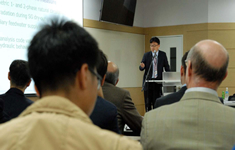 First test of the ATLAS nuclear safety research project completed with success
First test of the ATLAS nuclear safety research project completed with success
On 21-23 October, the Advanced Thermal‑hydraulic Test Loop for Accident Simulation facility (ATLAS) Project held its second meeting in Daejeon, Republic of Korea. The main objective of the ATLAS Project is to provide experimental data for resolving key LWR thermal‑hydraulics safety issues related to multiple high‑risk failures highlighted in particular by the Fukushima Daiichi nuclear power plant accident, by using the ATLAS facility at the Korea Atomic Energy Research Institute (KAERI). An important highlight of this meeting was the reporting of the successful completion of the first test in the project matrix following an extensive modification to the original ATLAS test loop. This test was a several hour simulation of an important design extension accident scenario, the thermal‑hydraulic behaviour and accident management measures of a PWR reactor system undergoing a prolonged station blackout and the loss of a number of the active and passive cooling measures. The next stage in this test will be the preparation of the data for the project members to compare what happened experimentally with their computer code predictions. Such analysis will increase the confidence of safety analysts, NPP operators and regulators in proposed accident management measures.
Regulation of new reactors
The NEA Working Group on the Regulation of New Reactors (WGRNR), which aims to examine regulatory activities in the primary programme areas of siting, licensing and oversight for new commercial nuclear power reactors, met on 28‑29 October. At the meeting, participants worked on the use of the Construction Experience (ConEx) database, which contains a collection of operating and construction experience that is deemed to provide lessons learnt useful for the regulation of new build design, construction and testing activities. The participants also discussed the next volumes of the Report of the Survey on the Design Review of New Reactor Applications. In parallel, the WGRNR is preparing a report on construction oversight and is launching a new activity on regulatory control during commissioning.
Investigating the costs of decommissioning of nuclear power plants
The NEA Expert Group on Costs of Decommissioning, mandated with the objective of addressing economic and financial aspects associated with the decommissioning of commercial nuclear power plants, convened on 2‑3 October. Meeting participants included 20 experts from 9 member countries and the International Atomic Energy Agency (IAEA). Discussing the progress of the group's activities, experts addressed the issues, advancements and challenges related to the collection, interpretation and analysis of costs, including both the actual costs from completed projects and the estimated costs for ongoing and future projects. They also discussed the growing concern stemming from the paucity of quantitative data related to decommissioning costs still perceived as commercially sensitive in many organisations. Key elements related to financing, national approaches for securing the funds and measures for their oversight, control and protection were also appraised, based on the related country responses obtained through a survey. The group's report on decommissioning costs is expected to be completed in the first quarter of 2015.
Uranium Group begins preparations for the 26th edition of the "Red Book"
On 6‑8 October, the Joint NEA/IAEA Group on Uranium (UG) met in Windhoek, Namibia to launch the preparations for the production of the next edition of Uranium: Resources, Production and Demand. With continuing interest in uranium production and demand, a total of 35 delegates from 24 countries and the Euratom Supply Agency took part in the meeting, finalising the questionnaire and data collection process, as well as agreeing on the timing of data collection for the next edition. Participants were welcomed by the Namibian Minister of Mines and Energy, Isak Katali, who highlighted the importance of the industry to the regional and national economy. After the meeting, Uranium Group members toured uranium mining and milling facilities in the Erongo region of Namibia, including the currently producing Rössing Uranium Mine and the Langer Heinrich Mine, as well as the Husab mine which is currently under development and expected to begin production in 2015.
|
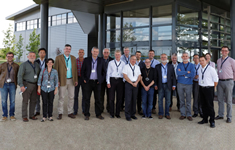 Discussions on diffusion characterisation in clay
Discussions on diffusion characterisation in clay
The NEA Clay Club met from 30 September to 2 October in Bure, France. In‑depth discussions on diffusion characterisation in clay were carried out during the topical session, which included presentations on recent research work on diffusion properties and migration of radionuclides in clay, performed by various national programmes. Complementing the topical session, the meeting programme included a visit to the Meuse/Haute‑Marne Underground Research Laboratory to view ANDRA's current ongoing research activities. The group decided to dedicate the 2015 topical session to discussion of approaches to upscaling techniques and site‑specific natural analogues within clay formations. In 2015, the Clay Club will also hold a workshop on how microscopic pore structures affect transport properties in shales in Scotland.
New activities on operational safety
On 6 October, the NEA Expert Group on Operational Safety (EGOS) reviewed the group's progress in completing its 2014 programme of work. Several projects, such as the management of fire risks in geological repositories, the development of an operational hazard database and the analysis of a questionnaire on co-activities in underground facilities, have made significant progress and the results of these projects are expected to be published in 2014/2015. Following an extension of the group's programme of work, in 2015 the EGOS will initiate two new activities on i) the development of waste acceptance criteria and quality control after waste acceptance, and ii) the organisation of a joint workshop with the IAEA on operational safety.
Handling of extreme geological events in a safety case
Over 50 members of the NEA International Group for the Safety Case (IGSC) and their representatives attended the group's 2014 annual meeting on 7‑9 October. Participants received the latest updates from other relevant NEA groups, international organisations and the IGSC's subgroups. Highlights of this meeting included new nominations to the IGSC Core Group, extensions of the durations of three expert groups – EGOS, the Salt Club and the Clay Club, the development of a source book which will be used to guide new IGSC work activities and the latest national safety case updates from members. The topical session of the 2014 annual meeting focused on the handling of extreme geological events in safety cases during the post-closure phase. The experience of nine national programmes and how they managed these extreme events in their safety cases were discussed.
Decommissioning in the Russian Federation highlighted
On 14‑16 October, the NEA Working Party on Decommissioning and Dismantling (WPDD) met in Moscow, Russian Federation, on the invitation of the State Atomic Energy Corporation "Rosatom" in order to foster the integration of Russian specialists and their decommissioning knowledge into international discussions and experience exchange on decommissioning topics. More than 45 experts from 13 countries including 25 working party members attended the meeting. In a topical session, discussions focused on optimising the management of low activity radioactive waste and materials from decommissioning. In a special session on decommissioning in the Russian Federation, Russian experts from different organisations presented their activities and practices in the field of decommissioning being conducted within their national regulatory framework and the Federal Target Programme "Provision of nuclear and radiation safety – 2008‑2015". The meeting ended with a technical visit to the National Research Centre of the Kurchatov Institute, where completed decommissioning projects, facilities undergoing dismantling and other nuclear facilities were shown to the participants.
New international nuclear emergency exercise
The International Nuclear Emergency Exercise (INEX) series, organised by the NEA Working Party on Nuclear Emergency Matters (WPNEM), has proven successful in testing, investigating and improving national and international response arrangements for nuclear accidents and radiological emergencies. On 14‑15 October, the WPNEM agreed on the concept of a new exercise in the series, building on the outcomes of the last exercise on consequence management and transition to recovery (INEX‑4). Each participating country will conduct a table‑top exercise addressing emergency management aspects of notification, communication and interfaces between and among countries and international organisations during the early phase of a release from a nuclear power plant due to a catastrophic natural disaster. The INEX‑5 exercise will provide an opportunity for participating countries to test and demonstrate the value of relevant changes put in place as a result of the Fukushima Daiichi nuclear power plant accident and will be announced later in November 2014.
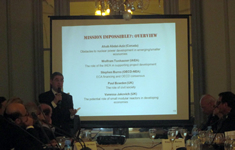 NEA participates in the International Nuclear Law Association Congress
NEA participates in the International Nuclear Law Association Congress
The NEA was a sponsoring organisation of the 21st Nuclear Inter Jura Congress which took place in Buenos Aires, Argentina, on 20‑23 October. Organised by the International Nuclear Law Association (INLA) and the Asociación Argentina de Derecho Nuclear, the congress brought together over 150 experts and practitioners from across the world to discuss contemporary issues in nuclear law, ranging from safety and security to safeguards, liability and financing. Participants included representatives of governmental and international organisations, private industry and public interest organisations. As part of the conference programme, the NEA organised a full-day session on nuclear liability and insurance and gave presentations on the progress towards a global nuclear liability regime as well as on the OECD Export Credits Arrangement and its particular provisions related to nuclear project financing as part of a discussion on the construction of new nuclear energy facilities.
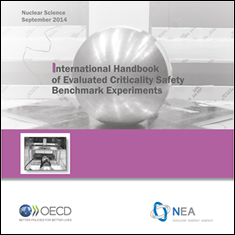 International criticality safety benchmark evaluation
International criticality safety benchmark evaluation
The 2014 edition of the International Handbook of Evaluated Criticality Safety Benchmark Experiments is now available, presenting evaluated criticality safety benchmark data in nine volumes that span over 67 000 pages. The handbook contains 561 evaluations with benchmark specifications for 4 839 critical, near-critical or subcritical configurations, 24 criticality alarm placement/shielding configurations with multiple dose points for each, and 207 configurations that have been categorised as fundamental physics measurements that are relevant to criticality safety applications. Requests to obtain the DVD should be made by completing the online Handbook Request Form. The handbook also includes an updated version of the Database for the International Criticality Safety Benchmark Evaluation Project (DICE).
24-OCT-14 |
ZZ COG-SUP-LIB, COG Supplemental Libraries for ENDL2011 and MCNP6.1-ENDF/B-VII. 1 |
|
24-OCT-14 |
COGLIBMAKER2014, Data Conversion Utility |
|
23-OCT-14 |
SAPHIRE 8.0.9, Systems Analysis Programs for Hands-On Integrated Reliability Evaluations |
|
23-OCT-14 |
COG 11.1 Beta2, Multiparticle Monte Carlo Code System for Shielding and Criticality Use |
|
23-OCT-14 |
SCEPTRE 1.4, Sandia Computational Engine for Particle Transport for Radiation Effects |
An online archive of previous editions is available here.
The monthly bulletin only lists new and updated material. It is distributed by e-mail to registered users of the Nuclear Energy Agency's Online Services. Registration is free; please use this link.